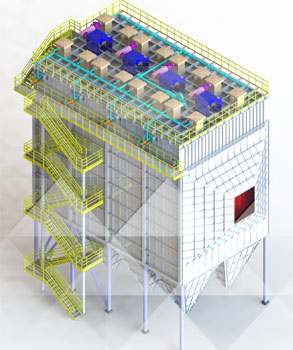Equipments
Dry Type Electrostatic Precipitator

Even though many will say that this is a novel technology, this piece of equipment was known as early as the 1920’s. However, cutting-edge technologies enable CRANFOS to design and build equipment with unprecedented efficiency and versatility levels.
The working principle for this piece of equipment is based on high-voltage ionization and electric-field capture of particles, where the voltage used range, depending on the process and application, from 20 KV to 80 KV.
In the current state of the art, this equipment works with low power consumption and low operating and maintenance costs, and in many cases it can reinsert the filtered gas into the production process. It is compliant with both the domestic and international laws concerning pollutant gas emission and power consumption parameters and values.
There are various construction schemes for our equipment to fit in the physical space available on the customer’s site. The horizontal design is the model used most often, with particulate matter collection boards standing vertically and parallel to each other. Hanging insulated electrodes in the pathways between said boards ionize the gas.
The Electrostatic Precipitator is entirely sized with the help of software specifically designed for structural calculation, resulting in a very sturdy and economical equipment assembly, which will vary according to the application type, where such factors are taken into consideration as internal pressure, the local wind load, amongst many others.
Internally, collecting plates are designed in order to prevent dust from returning to the flow after being electrically retained on the plate. Standard input and output funnels are used to provide, combined with table roll baffles and curtains, the best gas distribution, so that the equipment can evenly receive a part of the gas to be treated. Such distribution curtains underwent extensive physical and computer-aided testing until we finally set standards with minimal load loss and weight.
In the designing of emission electrodes, variables like resistivity and load of the particulate matter are considered so that they can be sized and manufactured for greater efficiency and lighter weight, as they are supported by the ceiling structure.
Special hammers are used to play the cleaning role. It is a periodic cleaning electronically controlled by a PLC. Such hammers bang against the bars to create the vibration required for releasing the particulate matter, which then falls down to the bottom of the equipment. Once the particulate matter is shaken, it is released from the collection board surface and falls down to the bottom of the hopper, where it is stored until transportation/packing.
There are a variety of designs for the bottom of such equipment, which may range from pyramidal hoppers to a flat bottom, where the material is mechanically scraped off to a discharge and transportation spot.
Such transportation is also taken into consideration at the design development, so that it can be designed upon identification of the best outflow control type for this material, such as a screw conveyor, for longitudinal hoppers, or just a rotary valve. Sets can even be put together with the two of these pieces of equipment, whether or not using a slide valve for added control.